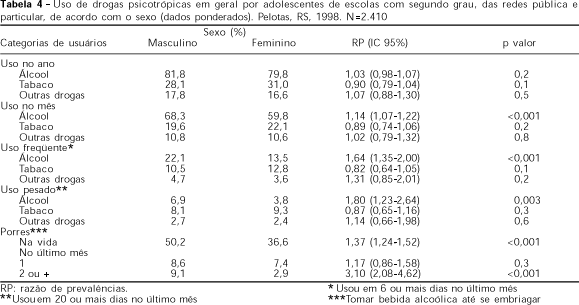OBJECTIVE: To assess the prevalence of drug use among teenagers. METHODS: A cross-sectional study was carried out in Pelotas, Southern Brazil, in 1998 . An anonymous, self-administered questionnaire was answered by a sample of 2,410 students with ages ranging from 10 to 19 years old, registered in all public and private high schools of the area. The schools were visited up to three times to reach absent students. RESULTS: The attrition rate was 8%. The substances mostly used by the students were alcohol (86.8%), tobacco (41.0%), marijuana (13.9%), inhalants (11.6%), anxiolytic drugs (8.0%), amphetamines (4.3%), and cocaine (3.2%). Marijuana, inhalants and cocaine were used mainly by male students, while anxiolytics and amphetamines were used mainly by female students. Alcohol consumption in the last 30 days, frequent drug use, heavy drinking and alcohol intoxication were more prevalent among males. After controlling for confounding factors, there was still an association between drug use (except for alcohol and tobacco) and evening courses, higher degree of nonattendance in the previous month and higher rate of school failure. CONCLUSIONS: The prevalence of drug experimentation among high school teenagers is high, indicating the importance of early detection of risk groups and development of programs to prevent drug abuse and addiction.
Substance-related disorders; Adolescence; Students; Underachievement; Adolescent behavior; Street drugs; Prevalence; Cross-sectional studies; Students; Socioeconomic factors; Epidemiology factors; Alcohol; Tobacco; Cannabis; Cocaine; Anti-anxiety agents; Drugs; Classroom performance





